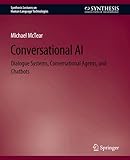Conversational AI [electronic resource] : Dialogue Systems, Conversational Agents, and Chatbots / by Michael McTear.
By: McTear, Michael [author.] .
.
Contributor(s): SpringerLink (Online service) .
.
Material type:  BookSeries: Synthesis Lectures on Human Language Technologies: Publisher: Cham : Springer International Publishing : Imprint: Springer, 2021Edition: 1st ed. 2021.Description: XVIII, 234 p. online resource.Content type: text Media type: computer Carrier type: online resourceISBN: 9783031021763.Subject(s): Artificial intelligence
BookSeries: Synthesis Lectures on Human Language Technologies: Publisher: Cham : Springer International Publishing : Imprint: Springer, 2021Edition: 1st ed. 2021.Description: XVIII, 234 p. online resource.Content type: text Media type: computer Carrier type: online resourceISBN: 9783031021763.Subject(s): Artificial intelligencePreface -- Acknowledgments -- Glossary -- Introducing Dialogue Systems -- Rule-Based Dialogue Systems: Architecture, Methods, and Tools -- Statistical Data-Driven Dialogue Systems -- Evaluating Dialogue Systems -- End-to-End Neural Dialogue Systems -- Challenges and Future Directions -- Bibliography -- Author's Biography .
This book provides a comprehensive introduction to Conversational AI. While the idea of interacting with a computer using voice or text goes back a long way, it is only in recent years that this idea has become a reality with the emergence of digital personal assistants, smart speakers, and chatbots. Advances in AI, particularly in deep learning, along with the availability of massive computing power and vast amounts of data, have led to a new generation of dialogue systems and conversational interfaces. Current research in Conversational AI focuses mainly on the application of machine learning and statistical data-driven approaches to the development of dialogue systems. However, it is important to be aware of previous achievements in dialogue technology and to consider to what extent they might be relevant to current research and development. Three main approaches to the development of dialogue systems are reviewed: rule-based systems that are handcrafted using best practice guidelines; statistical data-driven systems based on machine learning; and neural dialogue systems based on end-to-end learning. Evaluating the performance and usability of dialogue systems has become an important topic in its own right, and a variety of evaluation metrics and frameworks are described. Finally, a number of challenges for future research are considered, including: multimodality in dialogue systems, visual dialogue; data efficient dialogue model learning; using knowledge graphs; discourse and dialogue phenomena; hybrid approaches to dialogue systems development; dialogue with social robots and in the Internet of Things; and social and ethical issues.


There are no comments for this item.